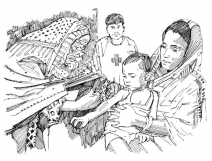26. Respiratory hygiene and coughing etiquette
26. Respiratory hygiene and coughing etiquette
Last update: 2023-08-02
Overview
- Many diseases are spread through particles or droplets that get in the air when people cough, sneeze, blow their noses or spit. There are some easy ways to minimize the spread of these diseases by practising good respiratory hygiene and coughing etiquette.
- The correct way to cough or sneeze without transmitting germs is to use a disposable tissue, a handkerchief or your sleeve. When you cough or sneeze into these, you are less likely to spread germs. If you use a disposable tissue, dispose of it safely as soon as possible. If you use a handkerchief, be sure to wash it frequently. Always wash your hands as soon as possible if you use a handkerchief or tissue when you cough or sneeze.
- Many people cough or sneeze into their hands to stop germs spreading. This is not the best practice. Afterwards, you can transmit the germs by touching things or shaking the hands of other people. The best thing to do is avoid coughing or sneezing into your hand. If you must use your hands, wash your hands with soap and water as soon as possible and without touching anything.
- It is also important to blow your nose and/or spit in a safe way. Tissues or handkerchiefs should always be used when you blow your nose or spit. Do not practise open spitting (for example, spitting onto the ground or into spittoons), always use a tissue or handkerchief (tissues are preferable and should be disposed of safely as soon as they are used).
What to do and how to do it
Hygiene promotion
Promote respiratory hygiene and coughing etiquette to people in your community.
- Ask your schools and other places where people gather in groups if they would like you to come and speak about respiratory hygiene and coughing etiquette.
- Explain that coughing etiquette matters because it helps to prevent the transmission of diseases that are spread through droplets carried in the air.
- Show people how to cough properly and ask them to teach the same behaviour to others.
- When talking about coughing etiquette, also teach people about proper hygiene and social distancing (see Action Tools Social distancing and Handwashing with soap).
- Make posters that show the DOs and DON’Ts of coughing etiquette and put them up around your community. (See Action Tool Social mobilization and behaviour change for more information on social mobilization techniques).
- In some countries, chewing Khat or chewing tobacco is widely practised. In these places, volunteers should explain that gathering in enclosed and poorly ventilated areas to chew and spit (khat or tobacco) for extended periods of time may increase the spread of germs and increase the risk of transmission of respiratory infections.


